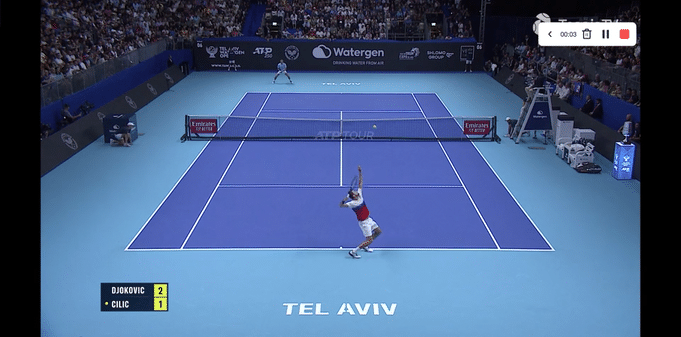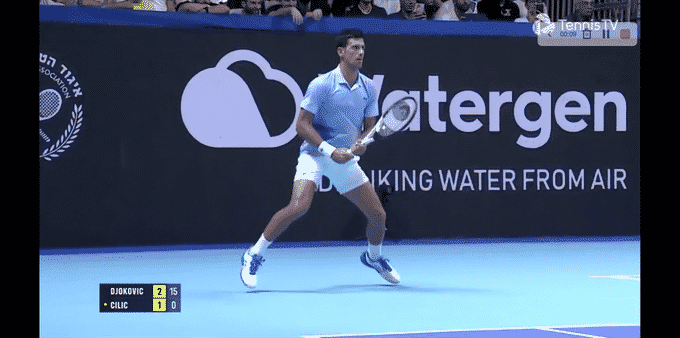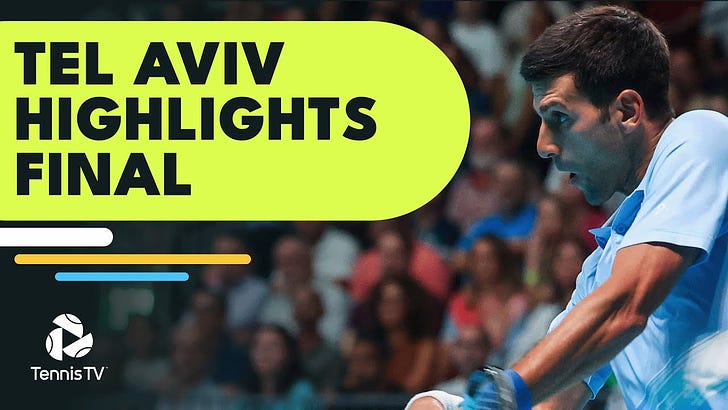Djokovic v Cilic: Tel Aviv Final Analysis
Corner defence—controlled aggression—unreturned serves
Novak Djokovic defeated Marin Cilic 6/3 6/4 to win the maiden edition of the Tel Aviv ATP 250. He now leads Cilic 19-2 in their H2H.
It was a vintage performance from Djokovic, who absorbed Cilic’s best shots and applied relentless depth and pressure from all corners. The opening points highlighted the exceptional movement and balance that are hallmarks of his game.


While absent from this year’s US Open—won by the ultra-aggressive Carlos Alcaraz—the Serb put on a clinic in percentage tennis and showcased a style that has dominated the tour for over a decade. It is still the gold standard in my eyes. Corner defence married with controlled depth and subtle change-of-direction may not make for good highlight reels, but it allows him to effortlessly tear apart quality top-20 opposition without getting out of mid-gears.

Close-up from the same point:

Toward the end of the first set the commentators acknowledged the impossible task Djokovic presents:
“It’s just so tough…Djokovic neutralizes so well and then you’ve just got to start all over again.”
I’ll add that he is also dangerous from the corners on the run, something that is exceptionally hard to do well.

A look at the official stats confirms how clean he kept it from his end:
What is interesting here is how good he can make an opponent look on the stats sheet. Djokovic wins a lot of points forcing errors out of his opponent, something that isn’t marked in typical post-match analyses. Cilic played pretty clean tennis from my view, but his game is far too “normal” to trouble Djokovic; you need to play more chaotic (like a Kyrgios or Federer) or completely starve him for pace, height, and angle (best demonstrated by Medvedev, Roberto Bautista Agut, and Dan Evans). Cilic isn’t suited for either, and his instinct to trade heavy blows—which usually serves him so well—played right into the Serb’s hands.

Here’s the final backhand from Cilic’s end:

One reason Djokovic hasn’t captured the attention of fans to the extent of Federer and Nadal is because he plays a very disciplined and constricting form of tennis. In boxing terms, Federer, Kyrgios, and Nadal appear to be knocking guys out. Novak is winning on points. That might be oversimplifying it, but the point is that while his strengths are not as salient, he is the ultimate percentage player in both technique and tactic. I’ve touched on this previously when discussing technique here. An excerpt:
“but there is a cost to everything, and the cost is going to be consistency and accuracy.” The percentages are going to ever so slightly favour Djokovic, and it might not really pay off until the pressure rises, perhaps in a tie-breaker or fifth set, but when it does, these costs are amplified.

Even on serve Djokovic has become a sneaky great; the stats will show he hit 7 aces today, but he also hit a further 15 first-serves that Cilic barely got a good play on. Combined, nearly 40% of his first serves didn’t come back. Again, the speed isn’t blistering, but it’s enough to make you miss. The point is forgettable, and only the scoreboard takes note.
While Alcaraz has taken the mantle of world number 1 and even beat Djokovic in Madrid back in May, it will be interesting to see them come to blows on a hard court. My firm belief is that Djokovic will lockdown the Alcaraz game if anywhere near his best. Both are in the Astana draw for this week, and with any luck, we might get a rematch of their Madrid classic.
A note on equipment
At various times I’ve hinted that a heavier racquet (or more specifically, a higher swingweight) may be better for shot development and nudge players toward simple technique. An excerpt from a previous article quoting impactingtennis.com:
1. “High swingweight smoothes out the strokes and it makes it almost impossible to just arm the ball with bad technique. That is because the racket has a higher moment of inertia and you have to generate more momentum with your hand to get it moving and small deviations of your hand movement and muscle action don’t affect the racket head position and path so much.” You can see in players like Wawrinka (SW 360) and Djokovic (SW 370) the quiet wrist and huge torso rotation they use in their shots.
2. “More control and consistency also comes from the fact that with a higher swingweight you can swing at lower swing speeds to get the same amount of power and spin.”
Further, Djokovic also uses a large grip (4 & 1/2 essentially as he uses two overgrips on a 4 & 3/8). A larger grip reduces wrist action, so even in this facet he’s sacrificed spin for control. Below is a table of some player frame specs.

I can’t think of any other player who has maximized control in every aspect of his game: wide base, big grip, quiet wrist, heavy stick1, counter-punching style. Deliberate or not it has made him an absolute monster that only Nadal (on clay) gets the better of.
Djokovic is drawn to play Cristian Garin in Astana.
Djokovic’s frame is based on a model from the early 2000s (racquet and string tech has basically been stagnant for 20 years). Dense string bed, natural gut, high swingweight, low stiffness, large grip, smaller head size. Every technical decision has been made with control in mind. (Note that Djokovic changed sticks in 2018 to something slightly more extended, lighter, and more open in string pattern. The numbers still look heavy and control-oriented).




"Cilic played pretty clean tennis from my view, but his game is far too “normal” to trouble Djokovic; you need to play more chaotic (like a Kyrgios or Federer) or completely starve him for pace, height, and angle (best demonstrated by Medvedev, Roberto Bautista Agut, and Dan Evans)."
That was a great article, as usual. Reading this paragraph made me wonder what's your take on the Nole vs Rafa matchup. It'd probably be fair to say that Nole has pretty much dominated him on hard courts after 2013, while still making the clay matches very competitive. But still, Rafa is undoubtedly one to trouble Novak. Would you think it's fair to say that he's been the most successful against him when he grinds less and takes more risks, thereby not getting sucked into Nole's baseline game?